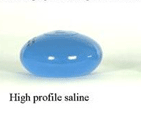Breast implants are used to help women achieve their desired breast size and shape. There is a diversity of implant types: saline-filled, silicone gel-filled, silicone/saline combination, PVP-Hydrogel and plant oil. There are round and anatomic implants. The rounded implant gives a fuller upper chest and cleavage. The anatomic or often called teardrop implants are sometimes recommended for skinny women because it may result in a more natural looking upper chest. The outer surface of the implant may be either smooth or textured. There is no conclusive evidence, but textured implants considered to help reduce the adverse effect of capsule formation around the implant. There are also various surgical techniques used to insert implants. Furthermore implants come in many sizes – depending on the amount of augmentation desired.
Saline breast implants
 These breast implants contain saline, sterile salt water. The implant is surgically inserted while empty and is filled after, which allows for some adjustment in size. According to some, the major drawback of saline breast implants is that they do not feel or look as natural as gel implants. In addition, many plastic surgeons believe that this type of implants tend to have a higher rate of leaking and deflation than silicone gel implants. On the other hand, if the saline does leak into the body, it is similar to other body fluids and is absorbed without harm.
These breast implants contain saline, sterile salt water. The implant is surgically inserted while empty and is filled after, which allows for some adjustment in size. According to some, the major drawback of saline breast implants is that they do not feel or look as natural as gel implants. In addition, many plastic surgeons believe that this type of implants tend to have a higher rate of leaking and deflation than silicone gel implants. On the other hand, if the saline does leak into the body, it is similar to other body fluids and is absorbed without harm.
Silicone breast implants
The implant consists of an elastomer envelope before breast augmentation surgery filled with a clear, sticky, thick jelly-like form of silicone that closely approximates the consistency of breast tissue. Silicone implant gained national attention and was banned in 1992 by FDA (Food & Drug Administration) when reports of leaking implants were linked to negative side effects. Since that time conflicting studies have emerged on the safety of silicone implants and as a result, there has been a push by some groups to reintroduce the silicone breast implant. Silicone breast implants are still readily available and regularly used by plastic and gender-reassignments surgeons throughout the world.
Plant oil-filled implants
They have been developed from the concern over health safety issues relative to the silicone gel-filled implant. These breast implants are filled with natural vegetable oil and offers greater safety for women. They are available throughout the European Union but still undergoing clinical trials in the US. The new implant called Trilucent contains triglyceride oil that has been used for 40 years as a nutrient in intravenous feeding and as drug carrier in injections. The manufacturers of Trilucent indicate like saline, it can be metabolized and excreted by the body, but it is also resistant to bacterial and fungal contamination whereas saline is not. However, there were some concerns about use of vegetable oil (if oil breaks down in the body it can potentially cause cancer or damage to a fetus).
Many of today’s implants have textured surfaces which are designed to reduce capsular contracture. However in US breast augmentations almost exclusively use a silicone shell filled with saline implants because of their safety and natural look. Recent developments use a variety of materials, but saline and silicone remain the most commonly used fillers.